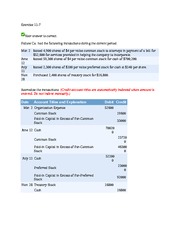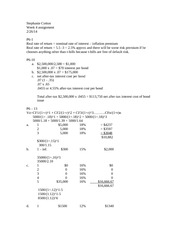What is other comprehensive income?

Understanding the Income Statement
Other comprehensive income can consist of gains and losses on certain types of investments, pension plans, and hedging transactions. It is excluded from net income because the gains and losses have not yet been realized. Investors reviewing a company’s balance sheet can use the OCI account as a barometer for upcoming threats or windfalls to net income. However, accounting for such securities differ from ‘trading securities’. Due to fair value treatment for “available for sale” securities, Unrealized gains or losses are included in the balance sheet on the asset side, however, such gains do not impact the net income of the Company.
Now, what I did though is I wrote that investment up through OCI. It’s a fair value through OCI, and I now have a balance and accumulated other comprehensive income of $15 attributable to this investment. I’m going to reclassify that gain by debiting OCI a loss, and then I’m going to call the deferred tax amount for $5 as well.
The fair value at the end of the year is $120, and then they sell it on January 31st for $110, tax rates 25 percent. So, we purchased it for a hundred dollars, and the fair value at 12/31 is $120. So, we’re going to debit the investment in the fair value OCI debt instrument for $20 to record the increase in the fair value of the instrument. But we’re going to credit it net of tax so we’ll have a deferred tax credit for five dollars which is equal to the 25 percent tax rate, and an OCI gain of $15 net of tax. And then we’ll also close OCI at the end of the year into accumulated other comprehensive income.
Now, this is a complicated thing that a lot of people really have a hard time getting their head around. Reclassification entries, again, they go through OCI and are not a direct debit or credit to AOCI. You do not directly debit equity for these amounts, you treat AOCI as an account that will be accessed by entries through other comprehensive income. So, for example, Laramie Cattle Company has an investment in a debt instrument that it accounts for as fair value through other comprehensive income.
Is accumulated other comprehensive income a debit or credit?
Accumulated other comprehensive income is a separate line within the stockholders’ equity section of the balance sheet. It is analagous to retained earnings which is accumulating the revenues and expenses that are reported on each period’s income statement.
What Is Other Comprehensive Income?
The Unrealized gains on such securities are not recognized in net income till they are sold and profit is realized. They are reported under shareholders equity as “accumulated other comprehensive income” on the balance sheet. The cash flow statement is also not affected by such securities. Accumulated other comprehensive income (AOCI) accumulates other comprehensive income (OCI), which records unrealized and realized gains and losses from certain transactions.
Now, if you take a close look at this, that gain is exactly my amortized cost gain because I bought it for $120, I sold it for $110, I gain $10. I achieved that result by recognizing the realized gain in year two by recycling, reclassifying the entry out of other comprehensive income. In year one, I recognized the $15 net gain in comprehensive income. And this reflects fair value accounting in comprehensive income and amortized cost accounting in net income and that’s a process that’s been formerly known as recycling, and formerly known as reclassification.
The ISP, however, is working on a new conceptual framework that may start to explain when you would use other comprehensive income. A general purpose of this is when you want to have the balance sheet perhaps at fair value but the income statement add an amortized cost basis, other comprehensive income becomes the reconciling item between the two.
The expectation frankly in both of those is that they will never recycle out of there. There’s also changes in the fair value of debt investments if they recognize at fair value through other comprehensive income. Changes in the fair value of own debt due to entity-specific factors when the fair value option is elected, we talked about this in the first part of this course.
It’s complicated, there’s not much we’re going to be able to do about that. Accumulated other comprehensive income (OCI) includes unrealized gains and losses reported in the equity section of the balance sheet that are netted below-retained earnings.
Examples of Other Comprehensive Income
- You will find quite a few accountants who think that the other comprehensive income shouldn’t even exist.
- In this lesson, we’re going to talk about accumulated other comprehensive income.
So, now we’re going to debit that gain to close the account, it’s a temporary account, and credit accumulated other comprehensive income. My accumulated other comprehensive income is a component of equity, I’ve now recognized this an equity net of tax. In year two, recall that we have recorded this investment now at $120, we paid $100 for it. So, I’m going to debit the account cash for 110, and now I have to clear the rest of the accounts in order to determine the gain or loss in the sale. Well, one of them is going to be the fair value at OCI account and that’s said, $120.
Now, I’m also then going to close that OCI loss into AOCI either at the end of the quarter or the end of the year and that will clear the amount out of AOCI. I don’t go directly to AOCI because if I did that, it wouldn’t show up in the statement of comprehensive income. One thing to remember is that you’re going to recognize some amounts if an amount reclassifies, you’re going to recognize again it was potentially three times. You’re going to recognize that in OCI when it originally happens, and when the amount is recognized in net income you will reclassify the amount out of OCI and recognize it in net income.
Is accumulated other comprehensive income part of retained earnings?
Accumulated other comprehensive income (OCI) includes unrealized gains and losses reported in the equity section of the balance sheet that are netted below-retained earnings. Other comprehensive income can consist of gains and losses on certain types of investments, pension plans, and hedging transactions.
The third time’s the charm, at which point you’re done with it. It’s complicated accounting, it does achieve the purpose of having the balance sheet at fair value, comprehensive income at fair value, and net income, and amortized cost which is a solution that is desired by many analysts and others.
Accumulated Other Comprehensive Income
In this lesson, we’re going to talk about accumulated other comprehensive income. Now, other comprehensive income is a very difficult topic for a lot of people. You will find quite a few accountants who think that the other comprehensive income shouldn’t even exist. You aren’t have others especially the users of the financial statements only, who insist on retaining this concept of other comprehensive income in the financial statements. The FASB hasn’t really defined other comprehensive income and they’ve been reluctant to make any measure that could legitimize it.
There’s changes in the fair value of derivatives and cash flow hedges. These are amounts that are expected to recycle when the hedge transaction affects net income.
So, some of the amounts again are not going to reclassify out of OCI, they’ll just be offset in future periods, but some amounts do reclassify out of OCI. Some of them are due to the realization of previous amounts that are recognized in OCI and these are referred to as reclassification entries.
Sometimes, it’s recycled, which means that at some point in the future the amounts we put into other comprehensive income coming out in effect net income and sometimes they are not. Sometimes, they go into accumulated other comprehensive income and they more or less stay there until they’re offset in the future. So, here’s some examples of items that go into accumulated other comprehensive income. Required discussion on defined benefit plan accounting, remeasurement gains and losses. On the obligation and differences between the expected and actual amount of plan assets both went into accumulated other comprehensive income.
Currency translation adjustments when a foreign currency is a functional currency and hedging gains and losses. A point thing to remember, other comprehensive income is net of tax. So, it’s usually recognized with a deferred tax asset or liability, the net amount is then closed into accumulated other comprehensive income at the end of the accounting period. And again, accumulated other comprehensive income is a component of equity. The same as retained earnings, the same as APIC, your additional paid in capital, the same as common stock, the same as preferred stock t, he same as warrants and options.
